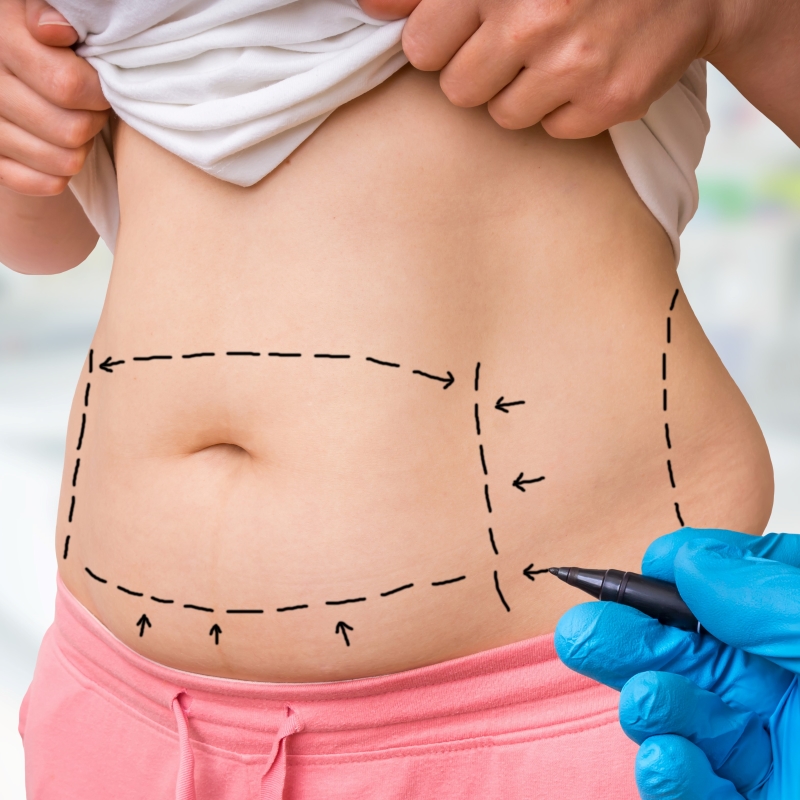
You’ve done everything right! You dieted, exercised and finally lost all that extra weight you’ve been carting around. Or maybe you religiously followed all your doctor’s instructions to remain safely trim and as healthy as possible while pregnant. Yet, no matter how hard you worked at it, you’re stuck with that loose dewlap-looking fold of skin hanging around your tummy. It just won’t go away! You’ve researched and considered many available options, but realize your only remedy is probably a tummy tuck. You’re almost ready to commit to having one, but you still have questions.
At Cherokee Women’s Health Specialists, we understand and are more than qualified and happy to answer all your concerns, both in this forum and during your free consultation.
What is a Tummy Tuck?
A tummy tuck, or abdominoplasty, is a procedure that surgically removes superfluous skin and fat around the abdominal area distended by pregnancy, former surgery, obesity, accelerated weight loss, age, or heredity. It also repairs the slackened or separated muscles (diastasis recti) caused by these factors. In some cases, depending on their location, some abdominal marring such as cesarean section scars and stretch mark can even be eliminated. The result of an abdominoplasty is a firm, flat stomach and a more appealing profile without those unwanted bulges or bumps.
Are all Tummy Tucks the Same?
No, there are several different types of tummy tucks. The one is best for you depends entirely on your individual needs and desired results. Our experts will advise you accordingly, but the following are the three most common abdominoplasty methods:
- Standard or Full Tummy Tuck: This procedure addresses the area both below and directly above the navel (umbilicus). Under sedation, a predetermined incision, based on the amount of excess skin to be removed, is made horizontally between the hips. Another is made around the umbilicus, which is carefully excised for repositioning afterward. The abdominal skin is then pulled back. Damaged muscles are tightened and tissue is removed. Liposuction, if required, is performed, Remaining skin is tightly pulled together and closed. The belly button is then replaced in a centered position. The standard tummy tuck is usually the method used when there is a large amount of surplus skin and/or muscle weakness.
- Mini Tummy Tuck: This method is less invasive and only concentrates on the area of the lower abdomen beneath the belly button. It is ideal for slimmer patients with a slight bulge. Muscles are tightened and extra skin is removed, but there is no need for navel extraction and consequent readjustment.
- Circumferential Lower Body Lift: This is the most invasive tummy tuck procedure and the one that yields the most dramatic results. It not only encompasses the entire abdomen but also targets the lower back and hips, resulting in a total upper body reshaping. It requires both vertical and horizontal incisions, allowing the surgeon better access to more compromised muscle and excess tissue. Then liposuction is used to draw out fat located around the hips and lower back for a more defined silhouette. The belly button is replaced as in a standard tummy tuck before closing.
Because this is a more intense surgery requiring a longer period of recuperation, patients must be in extremely good physical health.
Am I a Good Candidate for a Tummy Tuck?
You are a good candidate if you:
- Are in good health
- Are a non-smoker
- Are between 25 and 60 years of age
- Have good skin elasticity and muscle tone
- Have a great deal of loose, flabby skin: There must be enough skin to perform a standard tummy tuck so that the resulting scar does not become stretched and unsightly after healing. If you only have a small pocket of skin, the preferred choice is usually a mini tummy tuck.
- Realize that abdominoplasty is not a weight loss procedure or miraculous overnight makeover.
- Are committed to weight and good nutrition maintenance, a healthy lifestyle, and regular exercise
- No longer plan to become pregnant: Unexpected pregnancy after a tummy tuck is not harmful to a baby, but additional surgery to correct subsequent loose skin may be needed.
- Are within 15 to 20 pounds of your ideal weight with no plans to lose more.
Who Should Not Have a Tummy Tuck?
An abdominoplasty is a low-risk elective plastic surgery, but surgery nonetheless. Full medical history disclosure is needed, including a list of all prescribed, over-the-counter medications, vitamins, herbs and supplements you use. Additional preoperative tests must be performed. Information from all sources is used to ensure that all precautions are taken to determine that you can safely tolerate the procedure. Possible reasons that make you a poor candidate are:
- An intolerance to the anesthesia
- Lung, heart, kidney, liver, or connective tissue issues
- A tendency to develop keloids or other thick scarring problems (hypertrophic scarring)
- Healing difficulties caused by certain medical conditions such as diabetes, coronary artery disease etc.
- A compromised immune system
- Obesity
- Poor circulation
- A tendency to form blood clots.
What is the Recovery Time After a Tummy Tuck?
Your surgeon is usually the best person to answer this question, based on individual factors and type of surgery, but typically the recovery time is 2 to 6 weeks. This is usually the time allotted before the patient can return to work unless the job involves heavy or rigorous activity. Otherwise, the recuperation may be longer.
Will I Need to Stay Overnight After a Tummy Tuck?
Most tummy tucks do not necessarily require an overnight hospital stay, but some physicians–and patients–prefer it. You are usually physically able to leave within two hours.
I’m a Busy Mom. Can I Resume Care of Children After a Tummy Tuck?
It is crucial that the repaired muscles heal after an abdominoplasty. Any undue stretching of can cause tearing and stitch separation. Not only can this cause complications, but the desired abdomen flattening will not occur, rendering the whole process ineffective. You are usually cautioned not to lift anything over 10-15 pounds, and then, carefully. A wiggling toddler or baby can seriously jeopardize your healing process. Alternative, temporary accommodations, such as daycare or in-home help should be arranged.
What Precautions Should I Take After a Tummy Tuck?
Just as your doctor will explain exactly what preoperative preparations you will have to make, your aftercare needs will be explained. Some instructions you can expect are as follow:
- You will be prescribed pain medication and antibiotics with detailed instructions, and must not drive while taking it. Someone must drive you home.
- You will have bandages and drainage tubes that will require scrupulous care and attention. You may be asked to document drainage output to establish that you are healing properly. (Drainage from the incision site is normal, beginning with blood and some clotting. Discharge will slowly clear in color.)
- You will be told to avoid baths and hot tubs and be advised to take showers facing away from the stream.
- You will be restricted from heavy lifting and strenuous activity.
- You may be given compression garments to wear for about 6 weeks.
- You will have to refrain from sexual activity until your surgeon gives you the okay. (Some oral contraceptives taken with antibiotics may be less effective, so alternative birth control is recommended.)
You will also be told to watch for signs that may indicate a problem. Call your doctor immediately if you experience:
- Redness or swelling at the incision site (numbness is normal)
- Any fever over 101 degrees
- Foul smelling drainage or discharge
- Severe postoperative depression
- Blackening of the skin
- Excessive pain not alleviated with medication.
Why Should I Choose Cherokee Women’s Health Specialists for My Tummy Tuck?
You naturally want the most experienced and accredited surgeon to perform something as important as a successful tummy tuck. Our Drs. Haley and Litrel are board certified urologists who are doubly accredited in OB/GYN and Female Pelvic Medicine and Reconstructive Surgery (FPMRS). The latter certification was earned by meeting highly stringent criteria set forth the by the American Board of Medicine. Acquisition requires years of training and experience and enables them to perform all cosmetic and reconstructive surgeries dealing with women’s health, wellness, and self-image.
Cherokee Women’s Health Specialists is also affiliated with the new Northside Hospital Cherokee where your procedure will take place. This state-of-the-art institution provides our surgeons with impeccable surroundings and the most up-to-date technology known to modern science, ensuring that you will receive the highest quality care available.
The decision to have a tummy tuck is a serious one requiring much consideration and personal reflection. With proper professional intervention, investing in an abdominoplasty can be a permanent solution to an otherwise unyielding cosmetic problem, providing self-confidence and a sense of pride in your outer appearance for decades to come.
For a free consultation with one of our double-board certified physicians, call 770.720.7733 to make an appointment.


